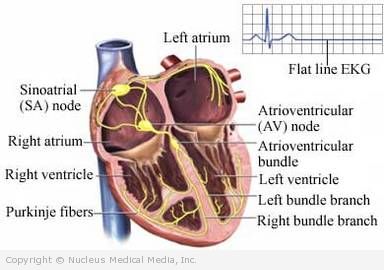Cardiac arrest
(Cardiopulmonary Arrest)
Cardiac arrest – Definition
Cardiac arrest means that the heart suddenly stops beating due to a problem with the heart’s electrical system. If emergency medical care is not provided right away, the person can quickly die because blood is not being pumped throughout the body.
Cardiac arrest is not the same as a heart attack. When a person has a heart attack, the blood flow to the heart is interrupted. This may be due to problems with the coronary arteries, like a build-up of plaque, a blood clot, or a thickening of the artery walls.
Cardiac arrest – Causes
Cardiac arrest may be caused by:
- Ventricular fibrillation — a rapid, irregular heart rhythm preventing any circulation of blood (most common cause of sudden cardiac arrest)
- Ventricular tachycardia — a rapid but regular heart rhythm that, if sustained, may turn into ventricular fibrillation
- Dramatic slowing of heart rate due to failure of its pacemaker or severe heart block (interference with electrical conduction)
- Respiratory arrest
- Choking or drowning
- Electrocution
- Hypothermia
- Sudden loss of blood pressure
- Unknown causes
Cardiac arrest – Risk Factors
Factors that may increase the risk of cardiac arrest include:
- Coronary artery disease
- Heart attack
- Cardiomyopathy
- Enlarged heart
- Congenital heart disease
- Heart valves that do not function properly
- Conditions affecting the heart’s electrical system
- Severe metabolic imbalances
- Adverse drug effects, such as from drugs to treat abnormal heart rhythms
- Lung conditions
- Trauma to the chest
- Extensive blood loss
- Excessive overexertion in people with heart disorders
- Drugs (eg, cocaine)
Cardiac arrest – Symptoms
Symptoms include:
- Loss of consciousness
- No breathing
- No pulse
Prior to cardiac arrest, some patients report the following symptoms or warning signs in the weeks before the event:
- Having chest pain
- Feeling weak
- Having a pounding sensation in the chest
- Feeling faint
Cardiac arrest – Diagnosis
The first person to respond to a cardiac arrest should check if the person is responsive. If the person does not respond, call 911 right away or have someone else call. If there is an automated external defibrillator (AED) available, you or someone else should get it and follow the steps on the machine.
After calling 911, CPR will be started if the person is not breathing normally. If no AED is available or while you are waiting for it, begin doing CPR by giving chest compressions. Push in the chest at least two inches at a fast rate of at least 100 compressions per minute. If you are trained in CPR, after 30 compressions, open the person’s airway and give two rescue breaths. Then, continue with the chest compressions. If you feel more comfortable, you can give the compressions without the breaths until the ambulance arrives.
Cardiac arrest – Treatment
Prompt treatment improves the chance of survival. The four steps in the cardiac chain of survival are:
Call 911
Immediately call for emergency medical support. Call 911 as soon as you notice cardiac warning signs or suspect a cardiac arrest has occurred.
Defibrillation
Defibrillation sends an electrical shock through the chest. The surge of electricity aims to stop the ineffective, irregular heart rhythm. This may allow the heart to resume a more normal electrical pattern. AEDs check the heart rhythm before instructing the rescuer to give the shock.
Start CPR
CPR helps keep blood and oxygen flowing to the heart and brain until other treatment can be given. The heart and brain are very susceptible to low oxygen levels. Permanent damage can occur, even with successful resuscitation.
Advanced Medical Care
Paramedics at the scene and doctors at the hospital provide essential medical care and intensive monitoring. They will give drugs, insert a tube to maintain an open airway, and manage emergency care. Epinephrine is often given early to make the heart more receptive to electrical impulses and to improve blood flow to the heart and brain. The patient will receive oxygen.
Therapeutic hypothermia is another type of treatment that may be used at the hospital. This involves lowering the person’s body temperature to 89°-93°F (32°-34°C) by using cold blankets, ice packs, and infusions of cool saline. This cooling of the body is done in effort to help brain function and recovery. The person’s body may remain at this temperature for an extended period of time (eg, 12-24 hours).
Even in cases where an effective heart rhythm has been restored, low oxygen levels can cause serious damage to the heart, brain, and other vital organs.
Cardiac arrest – Prevention
You may be able to lower your risk of cardiac arrest by:
- Learning the warning signs of heart disease and getting help right away if you develop any
- Talking to your doctor about ways to become healthier if you are already diagnosed with a heart condition — For example, your doctor may recommend that you take medicine to prevent arrhythmias.
- Asking your doctor if you should have an AED in your home if you are at a high risk of having cardiac arrest

